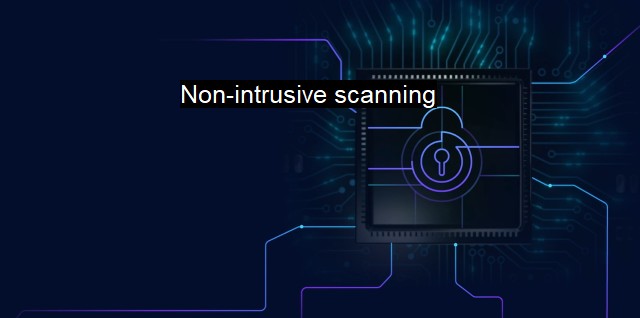What is Non-intrusive scanning?
Ensuring Network Security: The Significance of Non-Intrusive Scanning in Cybersecurity and Antivirus Systems
Non-intrusive scanning represents a crucial method used to identify, predict and mitigate potential threads of vulnerability in a system without disrupting or slowing down system operations. It is a complex and necessary part of maintaining security and functionality in countless modern digital systems such as financial applications, healthcare records, and governmental databases.Cybersecurity experts conceptualize non-intrusive scanning primarily as a tool for maintaining the integrity and safety of a network or system. At its core, its purpose lies in identifying loopholes such as hardware vulnerabilities, software aging, and configuration issues in a device or a network. It’s the frontline measure for protecting digital infrastructure and information from various unprecedented cyber threats and security attacks.
Non-intrusive scanning leverages several mechanisms and methods like APIs (application programming interfaces) and encrypted channels for remote administration. APIs provide an extension between different software applications, allowing them to communicate and interact while encrypted channels secure these interactions from any external infringement.
One of the key features of non-intrusive scanning is that it conducts inspections without impacting the workflow or routines of the system. This ensures that the systems can continue unhindered while the potential threats and weaknesses are identified and subsequently resolved. Appropriately enough, non-intrusive scans are often compared to health checks or medical scans for human bodies wherein symptoms are identified without interfering with the normal functioning of the individual.
Another element of non-intrusive scanning includes penetration testing, which imitates cyberattack scenarios in a thoroughly regulated environment to measure the vulnerability. Transmitting benign payloads to scan the host system or network, it helps in predicting possible attack patterns and developing preventive shields cuing upon any malignant activity.
Non-intrusive scanning also involves passive scanning where the system or network is observed diligently without reaching out or actively communicating with the devices on the networks. Firewalls, routers, network hosts, load balancers - everything falls under the radar of non-intrusive scanning, creating a culture of passive observation and active response.
Non-intrusive scanning can also be automated to ensure routine checks, saving human resources, time, and reducing mishandling. The principle of automated scanning is simple: the software performs a routine scan, looking for discrepancies or recognizing new devices that could potentially harbor threats.
In the world of antivirus, non-intrusive scanning refers to the ability of an antivirus software solution to perform continuous background checks on a computer without interrupting user activities, tying back to the foundational idea of non-interference with system or user activities. This operation is accomplished through smart scanning algorithms that partition the system resources efficiently avoiding any possible performance issues.
In a nutshell that's the essence of non-intrusive scanning — silently maintaining and enhancing the security of networks, systems, data, and much more. With the spiraling range and complexity of cyber threats, the importance of non-intrusive scanning techniques in cybersecurity and antivirus field will only increase. Embedding these techniques, businesses can detect and protect systems at the early onset, maintaining the confidentiality, integrity, and availability of data, while promoting a cyber-resilient environment. Despite its apparent complexity, non-intrusive scanning remains vital and integral, catering to diverse organizational needs by maintaining a robust, secure digital infrastructure.

Non-intrusive scanning FAQs
What is non-intrusive scanning?
Non-intrusive scanning is a type of cybersecurity scanning that does not require actual access to the target system. It is a passive approach to detect potential security risks, vulnerabilities, or malware without causing any disruption to the system or the network.How does non-intrusive scanning differ from intrusive scanning?
Intrusive scanning, also known as active scanning, requires a direct connection to the target system or network to probe for open ports, services, and vulnerabilities. Non-intrusive scanning, on the other hand, relies on network traffic analysis, log file examination, and other external sources of information to assess the security posture of the target.What are the benefits of non-intrusive scanning for antivirus software?
Non-intrusive scanning is an effective way for antivirus software to detect and prevent malware infections without interfering with the performance or functionality of the target system. It can identify suspicious behavior, files, or network traffic patterns that may indicate a security threat, and alert the user or security team accordingly. By utilizing non-intrusive scanning, antivirus software can provide a more comprehensive and proactive defense against cyber threats.Are there any limitations to non-intrusive scanning?
Non-intrusive scanning has some limitations, such as the inability to identify certain types of vulnerabilities or malware that may require deeper analysis or active testing. It also relies on external sources of information that may not always be accurate or up-to-date. Additionally, non-intrusive scanning may not be suitable for all types of systems or networks, especially those with strict security policies or sensitive data that require more invasive testing methods.| | A | | | B | | | C | | | D | | | E | | | F | | | G | | | H | | | I | | | J | | | K | | | L | | | M | |
| | N | | | O | | | P | | | Q | | | R | | | S | | | T | | | U | | | V | | | W | | | X | | | Y | | | Z | |
| | 1 | | | 2 | | | 3 | | | 4 | | | 7 | | | 8 | | |||||||